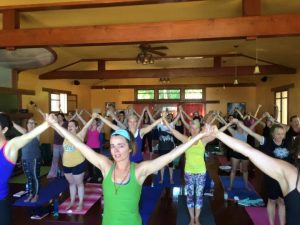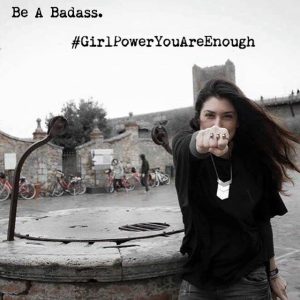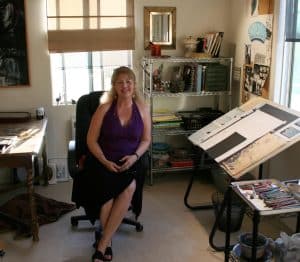By Jane O’Shields-Hayner
It was during that last, fragmented year of college when I found myself standing, once more, in a hot and rowdy crowd at what would be my last pep rally. My sorority required my attendance, to demonstrate support for the next upcoming football loss. My school lost pretty much all the time in those days and I had no real interest in football.
This was my fourth year of college and I was twenty-one years old. This semester I had registered for fifteen units of classes, and not attended a single one. Without a conscious thought, I had devised a simple way to sabotage my life.
My life was college life, and college was the vehicle I used to meet my whims. As a student, I could stay up late and hang out every night. I could dress in magazine fashions and boogie at the kind of parties where everyone drank as much alcohol as their gut would allow, then smile for photographs holding a paper cup while the blue light from the photographer’s flash bulb ignited and smoked.
I wasn’t new at slacking, but this year I had pushed slackhood past the point of no return. I dressed and drove my car from sorority row each morning while my friends left for class. Instead of parking at the main campus, walking inside a limestone building and facing one of the many professors I had never seen and never heard, I drove off in one of several other directions. I pointed the long nose of my yellow Mustang toward the highway, pushed on the accelerator until my toes touched the floor and dreamed I was flying. Three hundred horses of power propelled my wagon of yellow steel toward the horizon and then I was free. With a thrill in my heart, I raced past the contradictions, troubles and lies of my scrambled and misdirected life.
I drove around the lakes outside my Texas hometown, the ones where my boyfriend and I had parked for seven years of date nights, and sailed on weekends. I drove up and down freeways lined with long, undulating fields of Johnson grass and wheat. When I returned, late in the day, carrying only guilt inside my book bags, I managed to dodge and slide through any conversation whenever they turned to classes or grades. My friends knew I was sinking, and I did too. Occasionally one of my sorority sisters appealed to me with sad, serious eyes and I did my best “duck and cover” not to answer with any degree of honesty.
It was nineteen-seventy and the world was changing outside the college compound that was my home. Richard Nixon was president. The Vietnam War was burning its way through Southeast Asia and the United States had invaded Cambodia. Military planes loaded with coffins brought their loads stateside daily and, like a drumbeat in hell, the death count rose. Martin Luther King had been shot and killed two years earlier, and on that warm Texas day I had watched my religion professor wipe tears from his face as he crossed the campus lawn. For me, however, the war, the civil rights struggle and the world outside my little enclave was happening on TV, and I was watching “Laugh-In,” not the evening news.
My alter-life was my weekend job at Neiman Marcus; a hip, sophisticated environment where I was learning to live without much of the baggage I had carried throughout my youth. It was multi-ethnic, multi-racial and diverse. The store was filled with valuable, original artwork and intriguing objects. I made new friends. On my lunch breaks I hung around the display department with mannequins, mirrors, exotic items and people. Neiman Marcus was a trans-continental carnival and a cultural equalizer.
I knew I didn’t fit my college role any longer. I didn’t fit the future I was pretending to pursue and I hadn’t felt I fit in with my family for years. Every evening I smiled into the faces of the sweet, uncomplicated young women who were my friends, but I was in a dream. In my dream, I stood on a boat without sails, drifting from the shore, watching their faces grow more distant day by day.
The rally was held indoors because of the October heat and the auditorium was packed with standing revelers, shoulder to shoulder. Steam rose from the moisture that dripped beneath everyone’s clothing and the air was thick with hair spray, after-shave and sweat. One member of our cheerleading team stepped forward and introduced a squad of guest cheerleaders. I recognized the name of their school as an all black high school in town. She described their visit as an annual event, but I guess I was cutting a rally when they visited before, because they were new to me.
I tipped my wrist and looked down at my watch, wondering how much longer it would be before I could slip through the crowd and get away, but I was in for a surprise.
When the visiting cheerleaders came onto the stage dancing and chanting, the very air shook with a pounding energy and rhythm I’d never known. Suddenly I was awake. It was like The Rolling Stones were on that stage with a troupe of jitterbugging acrobats. It was the best performance I’d ever seen in that auditorium.
A long, vibrating roar rose and moved through the crowd. It ran through my bones, and hummed inside my ribs. Something was wrong. The tone of the crowd’s roar dropped several keys. I could barely see the cheerleaders now. I glimpsed their brown, dancing arms and legs through the crowd when space opened between the buttoned down shoulders of the college men. Sharp, staccato sounds began to punctuate the roar and I looked about and realized it was shrieking laughter.
The college students were laughing. Their heads were turning sideways, and they glanced back into the crowd, eyes scanning for other mocking faces to mirror their own. When they found them they would shriek, or stick out their lips. It became miserably apparent to me what was happening and I began to feel sick and trapped.
I didn’t know how to be anti-racist then. I had no model to follow in my Texas girl’s life. The stories of the violence and the courage of the civil rights movement were happening on TV, not in the streets of north central Texas. I had worked side by side with African American people by then, and I had found them to be just like me. I knew I was changing, but it was an invisible change and even I didn’t know how deeply the roots of equality were growing in me.
The packed auditorium made leaving impossible. Imprinted experiences from my childhood swam in the muck of my memory. The dark-skinned child I was chastened for playing with at the supermarket, the stories of white boys opening car doors to hit black boys walking on the side of the road, the calls of “nigger” shouted by children on playgrounds and by teenagers from moving cars. The calls lay in my memory like thrown bricks, indecent and unaddressed by teachers, preachers and other adults in our lives. With the adult world’s silent consent, the pervasive disease of racism lived unchallenged in the home of my childhood.
All I could do was abide in that dark mire and keep breathing. Invisibility is easy in a crowd, but I wanted more that day than to be invisible. I wanted to lead those dark skinned girls from the stage and take them someplace protected. I wanted the crazy racist shouters and laughers to all shut up. I wanted those dancing teenagers not to know they were being mocked. I wanted that more on that day than I wanted anything else and I was miserably ashamed to be in that crowd. I tried to imagine what the audience looked like from onstage, hoping those cheerleaders looked out and saw only darkness. It was a cold, bleak form of darkness I felt surrounding me on that pep rally afternoon, and it was all white.
For those who were comfortable in that crowd, the pep rally was a lesson of white superiority, a minstrel show; a humiliating ritual intended to keep the races apart. To me it was a seminal moment, a shameful experience that years later I would recall with anguish and anger.
Within weeks I left school. I had finally earned academic suspension for failing every class for which I had registered. I saw my future away from my privileged, contradictory life. I sold my belongings at a flea market and flew off to Colorado to discover there was a counter culture which I could join without application or recommendation. It was a loosely defined movement, attracting slackers and hucksters, idealists and opportunists, welcoming the adventurous and the confused. It was a groundswell of experimentation and those attending were making a new set of rules. Some were foolish and some had truth imbedded at their core. One truth was consistent, however. Wherever enclaves of this “counter culture” sprouted, racism did not have a home there, but for the time being, I did.
Jane O’Shields-Hayner is a writer and a visual artist. She writes essays, non-fiction, memoir, poetry and historical fiction, all addressing universal issues. She produces and exhibits drawings and paintings, which, like her written works, are expressions of her spiritual and biographical journey. Jane received Bachelor’s Degrees in studio art, art education and general education from Texas Christian University in Fort Worth, Texas, and a Master’s Degree in occupational therapy from Loma Linda University in southern California. She has a history as a teacher and a community and global activist, and she practices occupational therapy with a specialty in home health care. Jane’s husband, Bill Hayner, is also an artist and an educator. They have two young children and two adult daughters and they live in the foothills of the Santa Ana Mountains in Southern California. Jane has recently published work in Tiferet Journal, Friends Journal, The Manifest Station, and Western Friend. She has a piece soon to be published in the winter issue of Tiferet Journal. She is currently working on a memoir of her road trips pursuing the story of The Deportees described in Woody Guthrie’s Plane Crash in Los Gatos Canyon, and spanning the years of her diagnosis and treatment for breast cancer. She is also writing a biographical, epistolary novel about her beloved childhood horse, which is intended for readers of all ages.


Get ready to connect to your joy, manifest the life of your dreams, and tell the truth about who you are. This program is an excavation of the self, a deep and fun journey into questions such as: If I wasn’t afraid, what would I do? Who would I be if no one told me who I was?
Jennifer Pastiloff, creator of Manifestation Yoga and author of the forthcoming Girl Power: You Are Enough, invites you beyond your comfort zone to explore what it means to be creative, human, and free—through writing, asana, and maybe a dance party or two! Jennifer’s focus is less on yoga postures and more on diving into life in all its unpredictable, messy beauty.
Note Bring a journal, an open heart, and a sense of humor. Click the photo to sign up.

